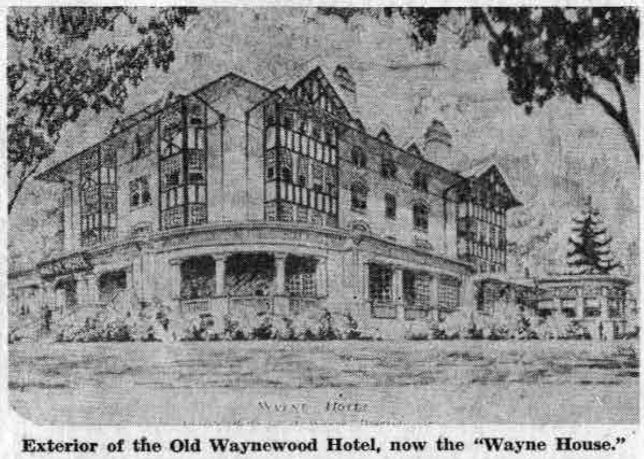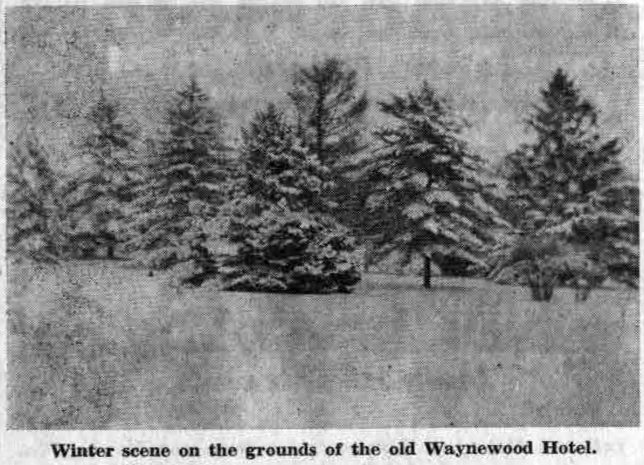
The date of the picture shown above is not known, but it was probably made to illustrate a small advertising folder which promised that “this delightful hotel in the beautiful Main Line country adjacent to Philadelphia is a perfect stopping point for permanent suburban residence. It is particularly suited to the tourist interested in Philadelphia and its historical landmarks, to the business man with calls to make in the area, to the family, and to the single person or ‘summer bachelor’ desiring a pleasant temporary or permanent country residence.”
Mrs. Malcolm Sausser, former assistant to Charles Wood, builder of the hostelry, recalls that its register contained many interesting names, among them that of the French consul to Philadelphia and his Belgian wife. Others on the list were a Mrs. Gardiner, who was the daughter of Henry Terry Baird, a prominent Philadelphian of his day, and Bodine Wallace and his mother.
Long-time residents of Wayne who lived at the hotel before buying homes of their own were Mr. and Mrs. A.I. Wood, with their daughter and son, Anne and Nelson, and Mr. and Mrs. John Turner, with their children, Velma and Warren.
Life was lived more formally in the early days of the Waynewood Hotel than it was later, a formality which often demanded evening dress for its guests when they assembled in the great dining room with its enormous bay window to the East. This sunny addition to the room shows very plainly in the picture. The tree to the extreme right is probably the same one that blew down the night of Hurricane Hazel which preceded the opening of Miss Kellogg’s restaurant by just 24 hours.
When Mr. Wood built his hotel the wide porch extended not only across the entire front of the building, but also around the east side as far as the bay window. This section was later enclosed with glass as shown in the picture, and remembering the days when guests enjoyed leisurely hours in rocking chairs on the side porch, Mrs. Sausser feels that the hotel lost some of its charm when the change was made.
 The picture shown above was taken by Mrs. Sausser when the porch was still open. The grounds of the Waynewood adjoined those of the Louella, neighboring shops had not been built, and on Louella court and Louella drive there were only trees, many of them dating back to the days of the Indians and the following Welsh settlers. Almost in the center of the background the familiar outlines of the old Louella, originally the home of the Askin family, can be seen.
The picture shown above was taken by Mrs. Sausser when the porch was still open. The grounds of the Waynewood adjoined those of the Louella, neighboring shops had not been built, and on Louella court and Louella drive there were only trees, many of them dating back to the days of the Indians and the following Welsh settlers. Almost in the center of the background the familiar outlines of the old Louella, originally the home of the Askin family, can be seen.
 This picture shows the same view as the preceding one, except that a heavy snow lay on the ground and weighted the branches of the trees. Another picture taken on the same snowy day shows St. Mary’s Church, just across the Pike.
This picture shows the same view as the preceding one, except that a heavy snow lay on the ground and weighted the branches of the trees. Another picture taken on the same snowy day shows St. Mary’s Church, just across the Pike.
When the once great lawns of the Waynewood and Louella gave way to businesses and homes, much of the beauty of their vistas was lost. One of the largest of the old trees, which grew on the site of Halligan’s store, became in 1922 Wayne’s official Christmas tree and the first community singing, led by Edgar L. Hunt, was held under its branches. Two years ago this December its place was taken by a handsome Douglas fir, planted at the entrance to the Wayne Presbyterian Chapel by Mr. and Mrs. Mortimer Newlin in memory of their son, Frank Battles Newlin.
As an interesting postscript to the story, Mrs. Sausser says that she remembers clearly the day she purchased the Brownie camera she used for the pictures. It came from Fronefield’s Drug Store, located on the corner the Sun Ray Company now occupies. Like Leinhardt’s Bakery, the shop was then approached by a flight of stone steps.
